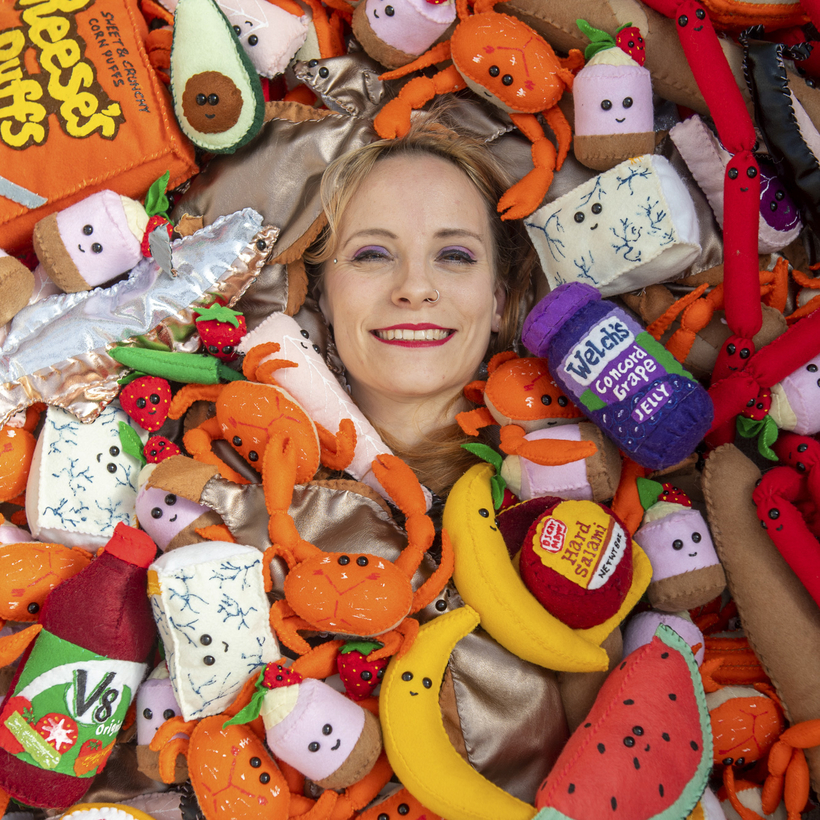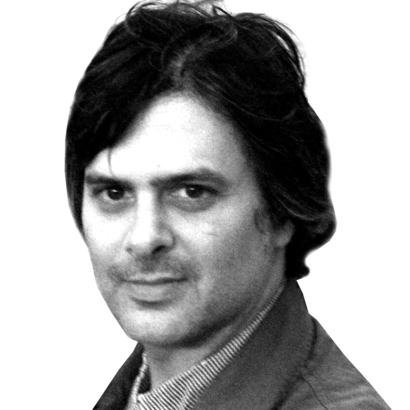When the British artist Lucy Sparrow was growing up on the outskirts of Bath, her bedroom walls were covered with the usual proliferation of posters and cutouts that, by international law, tweens and teenagers are required to have. But among the array of pop idols and their ilk were some unusual suspects: Andy Warhol, Damien Hirst, Tracey Emin, Claes Oldenburg. “When I’m older I’m going to be an artist,” she vowed.
Another preoccupation of Sparrow’s—involving soft, fuzzy, squeezable things—was already well established. Her bed was piled high with cuddly toys, at least 30 in all, with pride of place going to a prized collection of Beanie Babies, including a chameleon she christened Leon. There was also a plush banana with a pleasant face that she called Basil. One year, Sparrow took her birthday money and spent it on a beanbag chair, the one piece of furniture in existence most aligned with her aesthetic. She extolled its squishy virtues in an interview with the local newspaper: “You can flop in it.”

Sparrow, who is now 35, did grow up to be an artist. For most of the past decade, she has been one of the most visible upstarts among a new generation of British art stars. She has done this by creating immersive retail environments, which she turns out with an attention to detail that is painstaking, audacious, and even flabbergasting. In England, she made her first splash with The Cornershop, an installation that began as a humble Kickstarter campaign and then went viral after it opened in a moribund shop front in Bethnal Green in 2014.
This was followed in 2015 by Madame Roxy’s Erotic Emporium, a faux sex shop in London’s Soho that Sparrow packed to the rafters with toys, magazines, and S&M accoutrements. In America, she has created convenience stores and bodegas, such as her 2018 Sparrow Mart, at the Standard hotel, in downtown Los Angeles, and Lucy’s Delicatessen, at New York’s Rockefeller Center, the following year.
In all of these works, Sparrow stocks the shelves to capacity with the very items you might find at your local shop—thousands of them, from Spam to Marlboros, McVitie’s Digestives to Marmite. (In the case of Lucy’s Delicatessen, the inventory ran to 30,000 products.) These are handcrafted and sewn by Sparrow, who works in a studio she calls “the Felt Cave.” That’s because these products are made of felt—designed, cut, sewn, and painted. Some have little happy faces. The cash register is also felt. The money, though, is real: You can buy an ersatz pack of Twinkies or bottle of Heinz ketchup for about $100—a price point unheard of in the gallery world. If you wanted to buy an entire deli, though, it could run you $500,000.

On January 20, the artist is launching Tampa Fresh Foods, her biggest project yet, a 4,000-square-foot supermarket in Tampa, Florida, that she plans to fill with more than 50,000 handmade felt groceries. “I want people to question the sanity of the person who made it,” Sparrow said when I asked her about the project. “I want it to be overwhelming.”
Inside the Felt Cave
Sparrow’s Felt Cave is housed in a former ambulance station in the town of Sudbury, about an hour and forty-five minutes northeast of London. She invited me on a Zoom tour not long ago. “All my life I’ve been making stuff out of felt,” she said as she bounded up and down multi-colored rooms and hallways, past towering shelves stacked with a rainbow assortment of felt and fabric paint and thread, a garage where she parks her several vehicles (including a teal 1954 Ford Anglia), and a chill-out space consisting of a pile of plush bananas—replicas of her beloved Basil, which she now owns the trademark for and sells on her Web site, at sewyoursoul.co.uk. She settled herself into this yellow mound. “I sit here and contemplate everything when it gets too intense,” she said.
For most of the past decade, she has been one of the most visible upstarts among a new generation of British art stars.
It would be a cliché to compare Sparrow to a bird, but there you have it: She is slight of build, with keen, glinting eyes behind oversize black-rimmed glasses. Her Tweety-blond hair was in pigtails and she was wearing a souvenir T-shirt from the downtown-Manhattan clothing boutique Trash and Vaudeville. The aura is child-like, and the Felt Cave—where she harnesses the allure of plush toys to create 21st-century Pop art—feels like an extension of Sparrow’s bedroom in Bath.

“Felt,” as she told The Guardian, “is a fabric that is synonymous with primary school.” It is also a material that triggers something primary—a mix of surprise, joy, comfort, and incredulity—in every person who steps into her projects: reactions Sparrow gets to witness, as she attends every one of her installations for the duration as shopkeeper and till minder.
“It’s very overwhelming, seeing the expressions on people’s faces when they come in,” she told me of this participatory aspect of her work; it’s also exceedingly rare. Artists don’t generally hang around their gallery shows monitoring reactions. And audiences are usually too cool to react anyway. Not so much when they’re confronted by a rack of felt Tampax or Jujyfruits.

The artist’s father, Mark Sparrow, is a tech journalist and Forbes contributor who once counseled her: “Never be afraid to be a minority of one.” In her early 20s, after studying art and design at Bath College, Sparrow—who worked from time to time in supermarkets and as a lap dancer—became an “urban explorer.” She gave herself the handle “Rookinella,” dressed herself in Little Red Riding Hood–esque garb, and spent her spare hours poking around abandoned factories, hospitals, and asylums. She said of the smell of such moldering places: “For me, it’s like chocolate.”
As an artist, her medium at that time was essentially trespassing. It was dangerous work, resulting in at least one arrest. “It was an amazing 10 years,” Sparrow told me. “It wasn’t obviously an art form, but it kind of was.” She thought she might become a photographer, but even then there was sewing. Once, at an old tannery in Birmingham, Sparrow stumbled upon a cache of ostrich leather. She began making small, soft sculptures with this found material, including that most Oldenburgian of subjects, a hamburger. The piece—roughly twice life-size—still sits on a shelf in the Felt Cave.

Sparrow, after all, is arguably Oldenburg’s 21st-century heir: there’s the softness, the bright color, the canny oddness that makes everyday objects feel alien and new—toylike and yet vaguely discomfiting. Oldenburg’s pioneering 1961 retail environment, The Store, is something of a Rosetta stone. Which is to say that, in the true spirit of Pop, Sparrow’s work feels like an offhand conversation with art history, one that is, like the artist herself, notably unpretentious and totally accessible. (And, like Pop, there’s an undercurrent of nostalgia for familiar old products, advertising, and environments.)
In one of her early shows, she sewed felt versions of renowned paintings and sculptures, including one of Hirst’s notorious shark-in-formaldehyde piece, The Physical Impossibility of Death in the Mind of Someone Living, which she christened, with characteristic puckishness, The Impossibility of Felt in the Mind of Someone Sewing. Her Campbell’s tomato-soup can (available at her online shop) is the ultimate art-historical accessory, one that comes with a thoroughly modern disclaimer: “Warning cannot be consumed.”
“Sewing Ladies Wanted”
Sparrow made her first sale at age 23. It was a felt hand grenade, alarmingly cute, which went for $4.50. It took her two hours to make, which shook out to $2.25 an hour. These days, she has actual collectors (“A lady in South Carolina buys loads and loads of stuff”) and spends about $140,000 a year on felt. For the Tampa show, Sparrow has been working around the clock in the Felt Cave for nearly two years through the coronavirus pandemic. It might seem she needs a Jeff Koonsian number of minions in order to crank out the required number of items. But the Felt Cave remains more or less a cottage industry.
Sparrow now has four full-time assistants, and she farms out work when there’s a crush, taking out ads in the local papers: “Sewing ladies wanted.” They get sent piecework, likely never expecting that they would one day find themselves sewing TV dinners, rib-eye steaks, and Fanta cans. Sparrow herself works in the Felt Cave pretty much every day, knocking off around five or six to go home, have a bite, boot up Netflix, and continue sewing on the couch. The day we met, she was planning to spend the evening sewing lobsters for the seafood department at Tampa Fresh Foods.

Sparrow first scouted Tampa in early 2020, envisioning a felt supermarket on the scale of, say, Publix. She went around to 15 different places, taking photographs and making notes, including grocery stores, cigar shops, La Segunda bakery in the Ybor City neighborhood, and the historic Columbia Restaurant, best known for its “1905” salad (which, oddly, was created in the 1940s). Tampa Fresh Foods, underwritten by the Tampa-based Vinik Family Foundation and the Art Production Fund, will be tricked out with Florida-centric touches: aisles teeming with citrus fruits and watermelons, a Cubano sandwich station with all the fixings (not to mention a working sandwich press), and a climate-controlled humidor room with cigars.
It will take a full two weeks to install at the Water Street site, where Sparrow and members of her team will outfit themselves in yellow berets and smart tennis skirts, ringing up customers for the monthlong run. During that time, the piece itself will be in constant motion. “As soon as someone takes something off a shelf,” Sparrow pointed out, “everything is altered.” The effort, from concept to scouting to fabrication to installation to exhibition, is, well, insane. “It’s like endurance art,” she said with a burst of laughter. “Amazing concept plus hellish execution.”
When I asked Sparrow what she is most looking forward to during her time in Florida, she responded without hesitation: “Free refills.” Then she thought for a moment and mentioned IHOP. And beyond Tampa? No firm details yet, but the idea is 100,000 items, half of them in color and half in black and white: “Live supermarket, ghost supermarket.” The ghost items, she said, will have sad-eyed faces. She’s made some prototypes, and the real work will begin as soon as Tampa Fresh Foods is dismantled and she’s back at the Felt Cave, where, she said, there’s always more to do and each new project dwarfs the one before: “I’m always going bigger.”
Mark Rozzo is a Writer at Large for Air Mail and the author of the forthcoming book, Everybody Thought We Were Crazy: Dennis Hopper, Brooke Hayward, and 1960s Los Angeles

